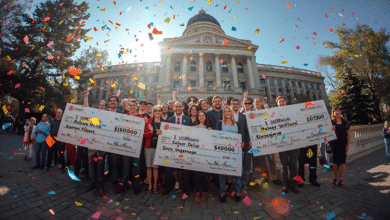Dave clark amazon Legacy: Innovations, Lessons, and What’s Next

Imagine working in a business where millions of orders flow every day, where speed matters, where complexity is the norm—fulfillment centers spread across continents, delivery schedules, robotics, people on the ground. That kind of environment demands exceptional leadership. One of the people behind Amazon’s scale and speed is Dave Clark. He spent 23 years at Amazon, rising through operations, shaping the logistics backbone, eventually running Amazon’s global consumer business. His story is not just about scaling infrastructure. It’s about innovation, tough choices, failures, lessons, and what comes after.
In this article, I want to take you through his journey—what he did at Amazon, what worked, what didn’t, what he’s doing now, what we can learn from him, especially in supply chain and operations. Whether you’re interested in leadership, operations, startups, or just curious, there’s a lot to learn from his path.
1. Early Life & Amazon Beginnings
Dave Clark joined Amazon fresh out of school (or early in his career). While I could not find exhaustive details on his childhood in public sources, what’s clear is that by choosing operations, he entered one of Amazon’s most intense domains—where delays, inefficiencies, and scale issues are front and center.
At Amazon, roles in operations are often the toughest school. Decisions have immediate consequences: a missed truck, a delayed shipment, safety issues, customer complaints. Clark embraced that challenge. Over time, he moved up through operations leadership, working in fulfillment centers, scaling processes, and owning large engineering and logistics responsibilities. His early work laid the foundation for the later innovations under his leadership.
2. Climbing the Ranks at Amazon
Over his 23 years with Amazon, Dave Clark held multiple executive roles. Some of the key ones include being Senior Vice President (SVP) of Global Operations, then moving up to lead Consumer Business globally, eventually becoming the CEO of Amazon’s Global Consumer Business.
What this meant: overseeing massive operations, a workforce of hundreds of thousands, billions in inventory and goods, vast networks of fulfillment centers, last-mile delivery, logistics technology, robotics, etc. One statistic: during his time as Consumer CEO, he managed a team of about 1.5 million people and was overseeing over $600 billion in gross merchandise sales.
He wasn’t just an operations exec; he was a leader of people, culture, growth, and technology integration. He got Amazon to scale speed, reliability, reach.
3. Key Achievements at Amazon
These are some of the areas where Dave Clark’s leadership made a big difference.
Fulfillment center expansion and speed
One of the core challenges for Amazon is “how quickly can we get a package to the customer.” Under Clark, Amazon pushed hard to expand fulfillment centers, regional fulfillment capacity, and to bring goods closer to demand. That meant more distributed warehouses, better forecasting, and continuous optimization. That leads to lower shipping times, fewer delays, and better customer satisfaction.
Last-mile delivery and Amazon’s Delivery Service Partners
Clark helped to scale Amazon’s last-mile network. For a long time, Amazon depended on external carriers for the “last mile” (i.e. the delivery from a fulfillment hub to the customer). Under Clark, Amazon built or acquired new capabilities: the delivery partner program; Amazon’s own trucks, vans, and logistics infrastructure. These improvements meant tighter control, better predictability, less dependency on third parties, and improved reliability. This has direct impact on cost and speed.
Read Also: Quality Roots: A Complete Guide to One of Michigan’s Most Popular Cannabis Dispensaries
Robotics and automation
As demand grew, so did complexity. Amazon invested in robotics, automation, and predictive systems to streamline picking, packing, inventory management, sorting, etc. Many decisions under Clark’s purview involved balancing human labor, automation, and technology to improve efficiency. Robotics helped reduce costs, increase speed, reduce human error, improve safety.
Customer-centric innovations
Beyond just moving stuff around quickly, Clark oversaw focus on customer experience—faster delivery promises (e.g., 1-day delivery), reliability, transparency. If a customer knows when their package will arrive, is satisfied with delivery reliability, those are direct wins for brand trust. Clark’s leadership pushed for these kinds of improvements.
4. Challenges & Lessons
No story of scale is without bumps. Some of what Dave Clark’s experience teaches comes from what didn’t go perfectly or what was hard.
Over-expansion risks
In scaling fulfillment centers, delivery fleets, and warehouse capacity, Amazon sometimes overestimated demand or misjudged which regions needed what capacity. These mismatches can lead to idle capacity (warehouses not used fully), cost overruns, wasted investments. For instance, during and after the pandemic, Amazon faced issues with overbuilt warehouse space. Such misallocation shows how forecasting at scale is always uncertain. I don’t have exact numbers here, but public reporting suggests these were real issues.
Organizational complexity
With teams numbering in the hundreds of thousands, supply chains spanning continents, software systems, human teams, regulatory variation, etc., things break. Communication gets harder, maintaining culture gets harder, aligning incentives gets harder. Leaders like Clark had to manage that—not just with strategy but with strong execution, feedback loops, learning from failures.
Employee and human side
Large operations involve many people. Worker safety, job satisfaction, transparency with labor issues, fairness—these are often places where companies are under scrutiny. While much of Clark’s legacy is operations and tech, there are times of criticism about how fulfillment centers are managed, how policies affect workers. Any leader scaling such operations needs to balance efficiency with human wellbeing.
5. Stepping Down & Time at Flexport
In 2022, Clark stepped down from his role as Amazon’s Consumer CEO. After leaving, he joined Flexport, a logistics company focused on freight, trade, supply‐chain software, etc. His time there was shorter, and reportedly involved challenges with alignment with the board. There were disagreements over management style, expectations, possibly strategy. Eventually, he resigned in 2023.
Although some viewed the exit as contentious, it also seemed to be a time of reflection for Clark. The experience highlighted that leadership in logistics technology isn’t just about operations—it is also about culture, clarity, product, technology, and stakeholder alignment.
6. Founding Auger: What’s Next
After Flexport, Dave Clark founded a new startup called Auger. This is more than a “post-Amazon side project.” It intends to address what Clark sees as a major gap: many enterprises still run parts of their supply chain with manual tools, fragmented systems, Excel sheets, disconnected data. Auger is meant to provide a unified, AI-powered supply chain technology platform, helping large companies get visibility, reduce inefficiencies, allow real-time decisions.
Some key facts:
-
Auger raised $100 million in its Series A round.
-
It targets companies with complex, global supply chains—manufacturing, distribution, retail.
-
Clark has publicly said “broken supply chains” are not just business problems but impact people—delays, higher prices, carbon footprint, etc.
Auger could be seen as Clark bringing together everything he learned: operations scale, tech, robotics, forecasting, leadership, human impacts.
7. Leadership Style & What We Can Learn
From observing Clark’s public speeches, interviews, and results, here are traits and lessons we can draw. If I were mentoring someone or building a supply chain startup, these are what I’d pay attention to.
a. Systems thinking & scale
Clark seems to think in systems: not just one warehouse or one region, but global flow. The interplay of fulfilment centers, transport, last-mile, inventory forecasting, robotics, people. Understanding the whole system, the dependencies, bottlenecks.
b. Data & measurement
You cannot improve what you do not measure. From what I gather, Clark pushed Amazon to get fine-grained data: how long each step takes, cost drivers, failure points. Then designing processes to reduce waste, delay, cost.
c. Embracing innovation & technology
Robotics, AI, automation, software. But also knowing when technology helps vs when simpler human processes are better. For example, there is cost and risk in automation; not everything should be automated. Clark’s work shows that correct balance between human capability and technology yields the best outcomes.
d. Willingness to accept trade-offs
Speed vs cost vs customer promise vs people concerns. Clark made tough calls: expanding capacity even when risk; investing in delivery capability; taking on political or employee pressure. Leadership involves making trade-offs and owning the consequences.
e. Learning from failures & missteps
Clark’s Amazon story is not all perfect. Some expansions didn’t pay off, mis-predictions of demand, high capital costs. But what matters is learning from them—adjusting processes, improving forecasting, understanding assumptions.
8. Future of Supply Chain Tech & Where Clark Fits In
With global trends, there is strong alignment with what Dave Clark is building now.
Trends to watch:
-
Supply chain visibility: many companies still lack real-time insight into where goods are, what delays will happen, how demand will shift.
-
AI & predictive analytics: forecasting demand, supply disruptions (weather, logistics, geopolitics), optimizing inventory & routing.
-
Sustainability: carbon emissions, waste, inefficiencies are big costs—financial, reputational, environmental.
-
Automation & robotics: in warehousing, sorting, transport.
-
End-to-end platforms: integrating software for forecasting, warehousing, fulfillment, transport, customer delivery.
Auger seems aimed at exactly these areas. If successful, it could help many companies move away from patchwork solutions (Excel spreadsheets, disconnected systems) to more unified platforms. Clark’s experience at Amazon gives him credibility, but building startup products, onboarding customers, delivering real value cost-effectively will be the real test.
9. Conclusion
Dave Clark’s journey from operations leader inside Amazon, through his time at Flexport, to founding Auger, offers rich lessons. He’s shown that large scale operations can be improved with innovation, data, and willingness to experiment. But such scale also brings risk—inefficiencies, overcapacity, complexity. The best leaders are those who see both sides: push forward, but also course-correct when needed.
If you’re in operations, supply chain, or aiming to build something in logistics or tech, studying his path can help you anticipate challenges and understand what real scale looks like. And going forward, the success of Auger will be a useful case study in applying everything one has learned in a lifetime at scale to the startup world.
FAQ
Q: What exactly did Dave Clark do at Amazon?
A: He spent over two decades in Amazon operations. He oversaw fulfillment, delivery logistics, robotics, expanded Amazon’s last-mile delivery network, improved customer speed and reliability, and ultimately led Amazon’s global consumer business with over $600B in merchandise and about 1.5 million employees.
Q: Why did Dave Clark leave Amazon?
A: He stepped down as Amazon Consumer CEO in mid-2022. The reasons cited are varied: after many years, he had built much of Amazon’s consumer operations; perhaps looking for new challenges. Then he joined Flexport, but there were differences with the board, strategy alignment, etc. Eventually he left and started Auger.
Q: What is Auger?
A: Auger is Dave Clark’s new supply chain technology startup. It aims to offer an integrated, AI-powered system for visibility, forecasting, decision support, helping large companies optimize supply chain operations. It raised $100 million in its Series A financing.
Q: What lessons can budding operations/tech leaders take from his story?
A: Some lessons: Think in systems, measure everything, embrace technology but balance with human factors, accept trade-offs, learn from failures, scale carefully. Also, culture and alignment matter—especially when moving into startup/leadership roles.
Q: What challenges might Auger face?
A: Competition (many supply chain tools), convincing large customers, integrating with existing systems, delivering real ROI, managing cost vs price, staying agile. Also, technical difficulties around AI, data integration, reliability.



